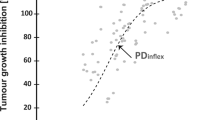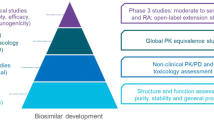Abstract
Purpose
Entrectinib (ROZLYTREK®) is a CNS-active, potent, and selective inhibitor of ROS1, TRK A/B/C, and ALK kinase activity. It was recently approved for the treatment of ROS1-positive non-small cell lung cancer and NTRK gene fusion-positive solid tumors. The main objective of this analysis was to characterize the pharmacokinetics (PK) of entrectinib and its main active metabolite, M5.
Methods
A total of 276 cancer patients receiving oral entrectinib were included in the analysis. A model-based population approach was used to characterize the PK profiles of both entities using NONMEM® 7.4. A joint model captures the PK of both entrectinib and M5. The effects of pH modifiers, formulation, weight, age, and sex on model parameters were assessed. Model performance was evaluated using visual predictive checks (VPCs).
Results
The absorption of entrectinib was best described using a sequential zero- and first-order absorption model and the disposition with one-compartment model for each entity with linear elimination. Moderate-to-high between-patient variability was estimated in model parameters (from 30.8% for the apparent clearance of entrectinib to 122% for the first-order absorption rate constant). Theory-based allometric scaling using body weight on clearances and volumes and a 28% lower relative bioavailability of the F1 formulation in pediatric patients were retained in the model. The VPC confirmed the good predictive performance of the PopPK model.
Conclusions
A robust population PK model was built and qualified for entrectinib and M5, describing linear PK for both entities. This model was used to support the ROZLYTREK® new drug application.




Similar content being viewed by others
References
Amatu A, Sartore-Bianchi A, Siena S (2016) NTRK gene fusions as novel targets of cancer therapy across multiple tumour types. ESMO Open 1:e000023
Aisner DL, Nguyen TT, Paskulin DD et al (2014) ROS1 and ALK fusions in colorectal cancer, with evidence of intratumoral heterogeneity for molecular drivers. Mol Cancer Res 12:111–118
Bergethon K, Shaw AT, Ou SH et al (2012) ROS1 rearrangements define a unique molecular class of lung cancers. J Clin Oncol 30:863–870
Malik SM, Maher VE, Bijwaard KE et al (2014) US Food and Drug Administration approval: crizotinib for treatment of advanced or metastatic non-small cell lung cancer that is anaplastic lymphoma kinase positive. Clin Cancer Res 20:2029–2034
Shaw AT, Gandhi L, Gadgeel S et al (2016) Alectinib in ALK-positive, crizotinib-resistant, non-small-cell lung cancer: a single-group, multi-centre, phase 2 trial. Lancet Oncol 17:234–242
Ou SH, Ahn JS, De Petris L et al (2016) Alectinib in crizotinib-refractory ALK-rearranged non-small-cell lung cancer: a Phase II global study. J Clin Oncol 34:661–668
Khozin S, Blumenthal GM, Zhang L et al (2015) FDA approval: ceritinib for the treatment of metastatic anaplastic lymphoma kinase-positive non-small cell lung cancer. Clin Cancer Res 21:2436–2439
Shaw AT, Ou SH, Bang YJ et al (2014) Crizotinib in ROS1-rearranged non-small-cell lung cancer. N Engl J Med 371:1963–1971
Liu D, Offin M, Harnicar S, Li BT, Drilon A (2018) Entrectinib: an orally available, selective tyrosine kinase inhibitor for the treatment of NTRK, ROS1, and ALK fusion-positive solid tumors. Ther Clin Risk Manag 14:1247–1252
Drilon A, Siena S, Ou SI et al (2017) Safety and antitumor activity of the multitargeted pan-TRK, ROS1, and ALK inhibitor Entrectinib: combined results from two phase I trials (ALKA-372-001 and STARTRK-1). Cancer Discov 7:400–409
Ardini E, Menichincheri M, Banfi P et al (2016) Entrectinib, a Pan-TRK, ROS1, and ALK inhibitor with activity in multiple molecularly defined cancer indications. Mol Cancer Ther 15:628–639
Ardini E, Lombardi Borgia A, De Ponti C et al (2010) Identification and preclinical characterization of NMS-P626, a potent, selective and orally bioavailable TrkA inhibitor with anti-tumor activity in a TrkA-dependent colorectal cancer. 22nd AACR-NCI-EORTC symposium on molecular targets and cancer therapeutics. Eur J Cancer Supplements 8:39–40
Menichincheri M, Ardini E, Magnaghi P et al (2016) Discovery of entrectinib: a new 3-aminoindazole as a potent anaplastic lymphoma kinase (ALK), c-ros oncogene 1 kinase (ROS1), and pan-tropomyosin receptor kinases (Pan-TRKs) inhibitor. J Med Chem 59:3392–3408
Ardini E, Menichincheri M, Banfi P, et al. In vitro and in vivo activity of NMSE-628 against ALK mutations resistant to Xalkori. Mol Cancer Ther. 2011;10(Suppl 1).
Anderson D, Ciomei M, Banfi P et al (2014) Inhibition of Trk-driven tumors by the pan-Trk inhibitor RXDX-101. EJC 50(Supplement 6):101
Parrott N, Stillhart C, Lindenberg M. Physiologically based absorption modelling to explore the impact of food and gastric pH changes on the pharmacokinetics of entrectinib. AAPS J (under review).
Meneses-Lorente G, Bentley D, Guerini E, et al. Characterization of the pharmacokinetics of entrectinib and its active M5 metabolite in healthy volunteers and patients with solid tumors. 2020 ASCPT Meeting. PII-050. https://ascpt.onlinelibrary.wiley.com/doi/https://doi.org/10.1002/cpt.1732
Drilon A, Siena S, Ou S-HI et al (2017) Safety and antitumor activity of the multitargeted Pan-TRK, ROS1, and ALK inhibitor entrectinib: combined results from two phase I trials (ALKA-372-001 and STARTRK-1). Cancer Discov 4:400–409
Holford N (1996) A size standard for pharmacokinetics. Clin Pharmacokinet 30:329–332
Holford N (2013) A pharmacokinetics standard for babies and adults. J Pharm Science 102:2941–2952
Anderson BJ, Holford NH (2009) Mechanistic basis of using body size and maturation to predict clearance in humans. Drug Metab Pharmacokinet 24:25–36
Almquist J, Leander J, Jirstrand J (2015) Using sensitivity equations for computing gradients of the FOCE and FOCEI approximations to the population likelihood. J Pharmacokinet Pharmacodyn 42:191–209
Owen JS, Fiedler-Kelly J. Introduction to population pharmacokinetic/pharmacodynamic analysis with nonlinear mixed effects models. Wiley 2014.
Savic R, Karlsson MO (2009) Importance of shrinkage in empirical Bayes estimates for diagnostics: problems and solutions. AAPS J 11:558–569
Bonate P (2006) Pharmacokinetic-pharmacodynamic modeling and simulation. Springer, Berlin
Yano Y, Beal S, Sheiner L (2001) Evaluating pharmacokinetic/pharmacodynamic models using the posterior predictive check. J Pharmacokin Pharmacodyn 28:171–192
Bergstrand M, Hooker AC, Wallin JE et al (2011) Prediction-corrected visual predictive checks for diagnosing nonlinear mixed-effects models. AAPS J 13:143–151
Elmokadem A, Riggs MM, Baron KT (2019) Quantitative systems pharmacology and physiologically-based pharmacokinetic modeling with mrgsolve: a hands-on tutorial. CPT Pharmacometrics Syst 8:883–893
Beal SL (2001) Ways to fit a PK model with some data below the quantification limit. J Pharmacokinet Pharmacodyn 28:481–504
Acknowledgements
The clinical studies reported in this manuscript were funded by F. Hoffmann-La-Roche (formerly Ignyta Inc., a member of the Roche Group). The modeling analyses were also funded by F. Hoffmann-La-Roche.
Funding
The clinical studies reported in this manuscript were funded by F. Hoffmann-La-Roche Ltd (formerly Ignyta Inc., a member of the Roche Group). The modeling analyses were also funded by F. Hoffmann-La-Roche Ltd.
Author information
Authors and Affiliations
Corresponding author
Ethics declarations
Conflict of interest
MG-S is an employee of Modelling Great Solutions. ND is an employee of Ignyta (owned by F. Hoffmann-La Roche Ltd.) GM-L is an employee of Roche Products Ltd. VB, NF and FM are employees of Roche Innovation Center Basel, F. Hoffmann-La Roche Ltd, Basel, Switzerland. GB was an employee of Syneos Health, who were contracted by F. Hoffmann-La Roche Ltd to support model development; he is currently an employee of Certara. P-OT is an employee of Syneos Health, who were contracted by F. Hoffmann-La Roche Ltd to support model development.
Ethics approval
All studies were carried out in accordance with principles for human experimentation as defined in the Declaration of Helsinki and were approved by the human investigational review board/ethics committee of each trial center, as required by ICH Guidelines for Good Clinical Practice.
Consent to participate
Informed consent was obtained from each patient after having been informed of the potential risks and benefits, as well as the investigational nature of each trial.
Consent for publication
Not applicable.
Data availability and materials
Qualified researchers may request access to individual patient-level data through the clinical study data request platform (https://vivli.org/). Further details on Roche's criteria for eligible studies are available here (https://vivli.org/members/ourmembers/). For further details on Roche's Global Policy on the Sharing of Clinical Information and how to request access to related clinical study documents, see here (https://www.roche.com/research_and_development/who_we_are_how_we_work/clinical_trials/our_commitment_to_data_sharing.htm).
Code availability
Not applicable.
Additional information
Publisher's Note
Springer Nature remains neutral with regard to jurisdictional claims in published maps and institutional affiliations.
Supplementary Information
Below is the link to the electronic supplementary material.
Rights and permissions
About this article
Cite this article
González-Sales, M., Djebli, N., Meneses-Lorente, G. et al. Population pharmacokinetic analysis of entrectinib in pediatric and adult patients with advanced/metastatic solid tumors: support of new drug application submission. Cancer Chemother Pharmacol 88, 997–1007 (2021). https://doi.org/10.1007/s00280-021-04353-8
Received:
Accepted:
Published:
Issue Date:
DOI: https://doi.org/10.1007/s00280-021-04353-8




